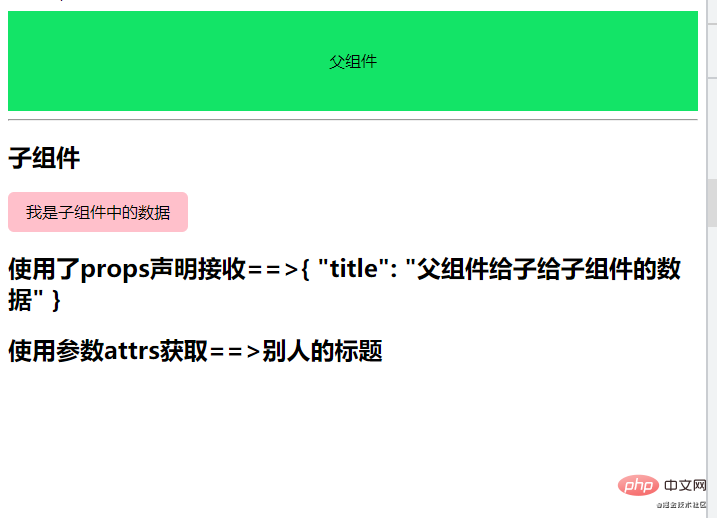所属分类:web前端开发
setup(props,context){}
第一个参数props:
props是一个对象,包含父组件传递给子组件的所有数据。
在子组件中使用props进行接收。
包含配置声明并传入的所有的属性的对象
也就是说:如果你想通过props的方式输出父组件传递给子组件的值。
你需要使用props进行接收配置。即props:{......}
如果你未通过Props进行接受配置,则输出的值是undefined【相关推荐:vue.js视频教程】
<template>
<div>
父组件
</div>
<no-cont :mytitle="msg"
othertitle="别人的标题"
@sonclick="sonclick">
</no-cont>
</template>
<script>
import NoCont from "../components/NoCont.vue"
export default {
setup () {
let msg={
title:'父组件给子给子组件的数据'
}
function sonclick(msss:string){
console.log(msss)
}
return {msg,sonclick}
},
components:{
NoCont
}
}
</script>登录后复制<template>
<div @click="sonHander">
我是子组件中的数据
</div>
</template>
<script>
import { defineComponent,setup } from 'vue';
export default defineComponent({
name: 'NoCont',
// 未进行接受
// props:{
// mytitle:{
// type:Object
// }
// },
setup(props,context){
console.log('props==>',props.mytitle);//输出的值是 undefined
function sonHander(){
context.emit('sonclick','子组件传递给父组件')
}
return {sonHander}
}
});
</script>登录后复制
前端(vue)入门到精通课程:进入学习
Apipost = Postman + Swagger + Mock + Jmeter 超好用的API调试工具:点击使用
为什么通过props.mytitle输出的值是undefined呢?
因为我们没有使用props进行接收配置。即
props:{
mytitle:{
type:Object
}
},登录后复制如果我们添加上接受配置
第2个参数:context,是一个对象。
里面有attrs(获取当前标签上的所有属性的对象)
但是该属性是props中没有声明接收的所有的对象。
如果你使用props去获取值,同时props中你声明了你要获取的值
则:获取的值是undefined
注意点:
attrs获取值是不需要props中没有声明接收。
第1个参数props获取值是需要props中声明接收的
有emit事件分发,(传递给父组件需要使用该事件)
有slots插槽
<template>
<div @click="sonHander">
我是子组件中的数据
</div>
</template>
<script>
import { defineComponent,setup } from 'vue';
export default defineComponent({
name: 'NoCont',
props:{
mytitle:{
type:Object
}
},
setup(props,context){
//输出{title:父组件传递的值}
console.log('props==>',props.mytitle);
// 输出别人的标题【使用context获取值,不需要使用props去接受】
console.log('context==> ',context.attrs.othertitle);
// 输出undefined,因为context不需要使用props去接受。
console.log('contextmytitle==> ',context.attrs.mytitle);
function sonHander(){
context.emit('sonclick','子组件传递给父组件')
}
return {sonHander}
}
});
</script>登录后复制
3. 子组件向父组件派发事件
<template>
<div @click="sonHander">
我是子组件中的数据
</div>
</template>
<script>
import { defineComponent,setup } from 'vue';
export default defineComponent({
name: 'NoCont',
props:{
mytitle:{
type:Object
}
},
setup(props,context){
function sonHander(){
context.emit('sonclick','子组件传递给父组件')
}
return {sonHander}
}
});
</script>登录后复制4.优化事件派发
我们知道第2个参数context是一个对象
并且对象中有三个属性attrs,slots,emit
在事件派发的时候,直接使用emit就ok了
<template>
<div @click="sonHander">
我是子组件中的数据
</div>
</template>
<script>
import { defineComponent,setup } from 'vue';
export default defineComponent({
name: 'NoCont',
props:{
mytitle:{
type:Object
}
},
setup(props,{attrs,slots,emit}){
//直接使用emit进行事件派发
function sonHander(){
emit('sonclick','子组件传递给父组件')
}
return {sonHander}
}
});
</script>登录后复制5.获取父组件传递的值
我们将使用props参数获取值
以及使用attrs获取值
<template>
<hr/>
<h2>子组件</h2>
<div @click="sonHander">
我是子组件中的数据
</div>
<h2>使用了props声明接收==>{{ mytitle }}</h2>
<h2>使用参数attrs获取==>{{ attrs.othertitle }}</h2>
</template>
<script>
import { defineComponent,setup } from 'vue';
export default defineComponent({
name: 'NoCont',
props:{
mytitle:{
type:Object
}
},
setup(props,{attrs,slots,emit}){
function sonHander(){
emit('sonclick','子组件传递给父组件')
}
return {sonHander,attrs}
}
});
</script>登录后复制
以上就是详解vue3中setup函数的参数-props和context的详细内容,更多请关注zzsucai.com其它相关文章!
